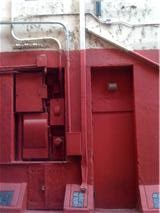Matthew Brown
Candace Nicol
Art 160
09/17/10
Not far away, yet still worlds apart.
While walking through a gallery I happened to stumble upon a certain painting. The artwork is entitled “Worlds Apart.” This piece seemed to draw me in and had an immediate impact in my minds eye. The plaque on the wall said it was painted by Chester Arnold in 1995 on linen. Looking back to the piece I see two dark cliff faces with green grass, trees and quaint little houses on the top. It looks fresh and new with bright blue sky's above and lush greenery abound. You can even see a new little house being constructed. Yet this painting takes a dramatic turn as your eyes scale downward. The cliff tops seem to be “divided by a deep chasm crumbling beneath them” (Piece Description). In the dark rocks you can see broken pipes draining liquid and sewage out into the deep gorge. When you look very closely you can even see little skeletons hidden within the rocks. The way this painting was constructed leads the viewers eyes downward from a brightly colored and cheerful top into the depths of an extremely shady chasm where you see a “bustling metropolis” at the bottom. The stark difference is that this little smog filled city in the distance is not pristine, in fact, it seems to be the polar opposite of the fresh country houses you see on the grassy cliff tops above.
To even begin to try and understand the painting, we must first do our best to try and understand the artist. “For Chester Arnold, painting is as much about social responsibility as it is about crafting luscious large-scale oil paintings in the tradition of 19th-century European artists. Since he began painting over three decades ago, Arnold has cleverly confronted a range of challenging subjects ranging from land use and environmental issues to the global impacts of human and industrial consumption, accumulation, and waste. The paintings united in this exhibition ask viewers to consider the implications of unchecked economic development and industrialized growth on the natural environment” (Nevada Museum of Art).
When I really took a step back and thought about the art piece I started to understand it a little more clearly. In my opinion, it was trying to imply that life is a fragile thing. It was trying to show how we have such a wonderful, natural and beautiful world. Yet with our deep seeded issues and disregard / disrespect for our own world, we get led downward into a dark place filled with congestion, filth, pain and even death. I believe this painting could be a metaphor and / or a reason to change the path we as a world are headed down. It sheds light on how the simpler times were a much cleaner and safer place to live. To be honest, I deeply enjoyed the exhibit, this painting and Chester Arnold's vision as an artist.
Work Cited
"Chester Arnold - On Earth as It Is in Heaven."
Nevada Museum of Art (2010): Web. 17 Sep 2010.
<http://www.nevadaart.org/exhibitions/detail?eid=157>.






























